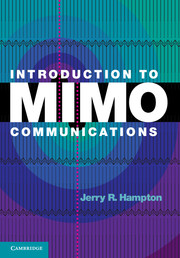Book contents
- Frontmatter
- Contents
- Preface
- 1 Overview of MIMO communications
- 2 The MIMO capacity formula
- 3 Applications of the MIMO capacity formula
- 4 RF propagation
- 5 MIMO channel models
- 6 Alamouti coding
- 7 Space-time coding
- 8 Spatial multiplexing
- 9 Broadband MIMO
- 10 Channel estimation
- 11 Practical MIMO examples
- Appendices
- References
- Index
7 - Space-time coding
Published online by Cambridge University Press: 05 December 2013
- Frontmatter
- Contents
- Preface
- 1 Overview of MIMO communications
- 2 The MIMO capacity formula
- 3 Applications of the MIMO capacity formula
- 4 RF propagation
- 5 MIMO channel models
- 6 Alamouti coding
- 7 Space-time coding
- 8 Spatial multiplexing
- 9 Broadband MIMO
- 10 Channel estimation
- 11 Practical MIMO examples
- Appendices
- References
- Index
Summary
In the previous chapter, we considered Alamouti space-time coding, which enables transmit diversity with optimum performance. As we saw, although Alamouti coding works with any number of receive antennas, it is restricted to cases where there are only two transmit antennas. In this chapter, we broaden our discussion and consider space-time codes that support more than two transmitters.
Since Alamouti's code was introduced in 1998, much research has been conducted in the area of space-time coding for MIMO applications, and space-time coding is now a broad field encompassing many different types of coding schemes. Space-time codes fall into one of two primary classes: space-time block codes (STBCs) and space-time trellis codes (STTCs). STBCs, in turn, fall into two subclasses called orthogonal space-time block codes (OSTBCs) and non-orthogonal space-time block codes (NOSTBCs). In this chapter we focus on OSTBCs because they have simple decoding schemes and are used in practical wireless systems.
The chapter begins with a general discussion of space-time coding concepts and terminology, followed by a section that derives criteria for designing space-time codes. Next, we describe OSTBCs in detail and describe how to decode them. After that, we include a brief section on NOSTBCs, listing some specific ones that have been proposed and giving references for further reading. We conclude the chapter with a section on STTCs.
- Type
- Chapter
- Information
- Introduction to MIMO Communications , pp. 131 - 161Publisher: Cambridge University PressPrint publication year: 2013



